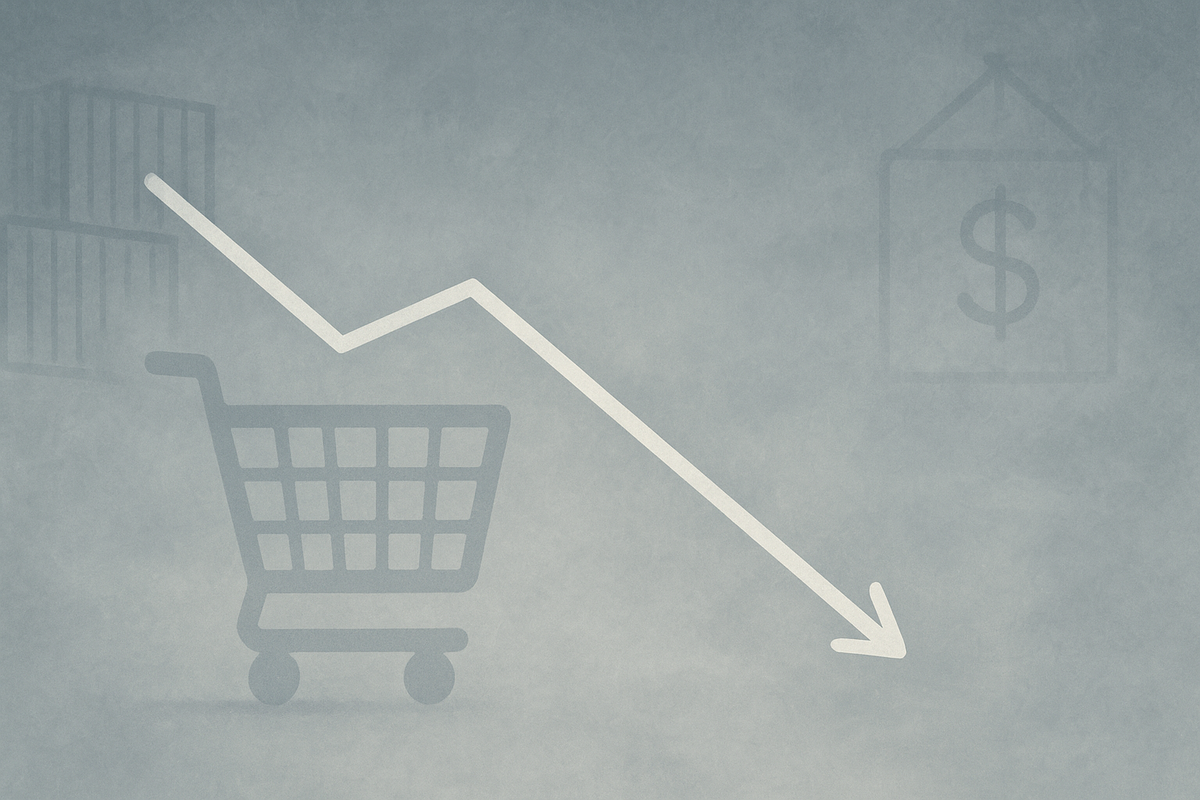
The American consumer, long a pillar of economic strength, is showing signs of fatigue in 2025. A period of modest growth in spending is now being overshadowed by a noticeable weakening in consumer sentiment, a trend exacerbated by the persistent uncertainty surrounding tariffs. This shift has immediate and far-reaching implications for retail sales, corporate earnings, and the broader economic outlook, signaling a potential slowdown that could reshape market dynamics in the latter half of the year.
While nominal consumer spending saw robust growth in 2024, the current year paints a different picture. Real consumer spending is projected to increase by a mere 1.4% in 2025, a significant deceleration from previous quarters. This slowdown, coupled with a palpable decline in consumer confidence, suggests that households are becoming increasingly cautious, prioritizing essential goods and delaying discretionary purchases amidst a landscape of rising prices and economic ambiguity.
What Happened and Why It Matters
The U.S. economy is currently navigating a complex environment where consumer spending, a critical driver of growth, is experiencing a notable deceleration. After a strong performance in late 2024, real personal consumption expenditures (PCE) saw a significant drop in the first quarter of 2025, with spending on durable goods particularly hard hit, declining by 3.8%. This indicates a shift in consumer behavior, moving away from big-ticket items.
Throughout 2025, consumer sentiment has steadily weakened. The University of Michigan consumer sentiment index plummeted by 18.2% between December 2024 and June 2025. Similarly, the Conference Board's Consumer Confidence Index reached a near five-year low in April, largely due to tariff-related anxieties. Although there was a modest rebound in July, the Expectations Index remains below the critical 80-point threshold, a level historically associated with impending recessions. August brought further concerns, with sentiment falling again, driven by increasing worries about inflation and a significant drop in buying conditions for durable goods.
The immediate implications of tariff uncertainty are profound. Contrary to some expectations that consumers might rush to buy ahead of price hikes, declining sentiment has led to a spending pullback. Tariffs are essentially a tax on U.S. importers, which are then passed on to consumers in the form of higher prices. The Consumer Price Index (CPI) is projected to average 2.9% in 2025 and accelerate to 3.2% in 2026, largely due to these tariffs. Trade organizations have vociferously warned that consumers are ill-equipped to absorb these increased costs, which will likely diminish product quality and erode confidence further. While some pre-tariff purchasing did occur, this trend is expected to subside, with the negative impact on demand intensifying in the second half of 2025 as consumers cut back on discretionary spending to manage their budgets. The lack of clarity surrounding tariff policies has already disrupted various industries, with retailers actively diversifying supply chains and adjusting product assortments to mitigate the anticipated cost increases. The public's perception of tariffs and their potential impact on prices is currently having a more significant effect on sentiment than actual measured inflation data.
The Shifting Sands of Fortune: Winners and Losers in a Cautious Market
The current economic climate, marked by slowing consumer spending, weakening sentiment, and tariff uncertainty, is creating a clear divergence between companies poised to thrive and those facing significant headwinds. This environment is reshaping business models and profitability across various sectors, particularly in retail, e-commerce, and consumer goods.
The Resilient and Resourceful: Potential Winners
Companies providing essential goods, offering value-oriented products, or boasting robust domestic supply chains are generally better positioned to weather the storm. Walmart (NYSE: WMT), for instance, is likely to see stable demand as consumers prioritize essential goods and seek out more affordable options. Similarly, consumer staples giants like Procter & Gamble (NYSE: PG), Colgate-Palmolive (NYSE: CL), and The Coca-Cola Company (NYSE: KO) are expected to demonstrate resilience. Their necessity-driven business models ensure relatively stable demand for food, beverages, household items, and personal care products, even during economic downturns. These companies may even benefit from consumers "trading down" from more expensive brands or opting for more in-home consumption over dining out.
Discount retailers such as Dollar General (NYSE: DG) and Costco (NASDAQ: COST) are also poised to benefit. Their core value proposition of lower prices becomes highly attractive to price-sensitive consumers during periods of slowing spending. They could experience increased foot traffic and sales volume as consumers actively seek out more affordable alternatives. Furthermore, companies with strong domestic supply chains or significant pricing power will be better equipped to absorb or pass on increased costs from tariffs without severely impacting demand.
The Vulnerable and Vexed: Potential Losers
Conversely, companies in the consumer discretionary sector, especially those reliant on imports or offering high-ticket items, are most vulnerable. This broad category includes retailers, automakers, travel and leisure companies, and those selling electronics, furniture, and appliances. Giants like Amazon.com (NASDAQ: AMZN) (particularly its e-commerce segments), Tesla (NASDAQ: TSLA), Home Depot (NYSE: HD), Target (NYSE: TGT), Nike (NYSE: NKE), and Starbucks (NASDAQ: SBUX) could face significant challenges. Consumer discretionary goods and services are "wants" rather than "needs," making their demand highly elastic and susceptible to economic pressures. When consumer confidence wanes and budgets tighten, these are often the first purchases to be deferred or cut. McDonald's and Starbucks, for example, have already reported slowing sales as consumers feel the pinch of high prices and reduce their dining out.
Many consumer discretionary products are imported, meaning tariffs directly increase their costs. This forces companies to either absorb the costs, compressing already thin margins, or pass them on to consumers through higher prices, which can further dampen demand. Hardline retailers, dealing in durable goods like appliances and electronics, could see significant reductions in earnings per share due to tariffs. E-commerce platforms, despite their past growth, are also facing a slowdown. While the pandemic fueled a boom, growth rates are normalizing, and consumers are increasingly returning to physical stores. E-commerce businesses are also heavily exposed to tariffs due to their reliance on global sourcing and international supply chains, leading to higher prices, dampened demand, and potential profit losses. Retailers with significant international supply chain exposure, particularly in apparel, footwear, electronics, toys, and home goods, will grapple with higher costs for imported goods, supply chain disruptions, and increased complexity in inventory management, ultimately squeezing profit margins.
Industry Impact and Broader Implications: A Shifting Economic Landscape
The confluence of slowing consumer spending, weakening sentiment, and tariff uncertainty is not merely a blip on the economic radar; it represents a significant challenge with wide-ranging implications for industries, businesses, and policymakers alike. This situation reflects a broader trend of economic deceleration and heightened market volatility, drawing comparisons to past periods of instability.
Slowing consumer spending, which historically accounts for a substantial portion of U.S. Gross Domestic Product (GDP), directly contributes to a slowdown in overall economic growth. This trend is particularly evident in consumer-facing sectors such as retail, hospitality, and manufacturing, where reduced demand for goods and services can lead to decreased revenues and, in some cases, job losses. The retail sector, for instance, has experienced negative net absorption for the first time in five years, with more store closures than openings, especially in non-essential categories. Weakening consumer sentiment, often fueled by inflation concerns and less favorable buying conditions, further exacerbates this slowdown. Consumers become more apprehensive about their financial futures, leading to a more conservative approach to spending and a heightened focus on value and affordability. This shift disproportionately affects cyclical sectors like new cars, patio furniture, and travel, while essential services and staples tend to be more resilient.
Tariff uncertainty adds another layer of complexity, as tariffs generally increase the cost of imported goods, which is often passed on to consumers in the form of higher prices. This can reduce the range of products available and increase the overall cost of living, further dampening consumer demand. Industries heavily reliant on imports or global supply chains, such as automotive, manufacturing, industrial, defense, pharmaceuticals, and high-tech electronics, are particularly vulnerable to these cost increases and supply chain disruptions. The slowdown in consumer spending and the impact of tariffs create significant ripple effects across industries. Companies, especially those in consumer-dependent sectors, face decreased earnings forecasts and potential stock market volatility. Many struggle to pass on higher costs to price-sensitive consumers, leading to reduced profitability. This can force businesses to cut back on operations, delay expansion or investment plans, and even lead to closures, particularly for small businesses.
This environment also prompts businesses to rethink their global supply chain strategies. Companies are exploring options like reshoring (bringing production back home) or nearshoring (moving production to nearby countries) to mitigate risks associated with geopolitical tensions and rising import costs. This shift can create opportunities for domestic logistics and manufacturing companies but poses challenges for international shipping and trade-dependent businesses. As consumers become more cost-conscious, competition intensifies, with a focus on value and affordability. Luxury brands and high-end retailers may experience a slowdown in sales as even higher-income households become more cautious. Governments and central banks often respond to slowing consumer spending and economic uncertainty with various policy adjustments. The Federal Reserve might respond to a significant downturn by adjusting monetary policy, such as lowering interest rates to encourage borrowing and spending or injecting liquidity into the economy. However, the effectiveness of these actions can be limited, especially if interest rates are already low or if inflation remains a concern. The imposition of tariffs is a tool of protectionist trade policy, aimed at defending domestic industries, but it often leads to retaliatory tariffs and can negatively impact global trade and economic growth. History offers several parallels, most notably the 1930 Smoot-Hawley Tariff Act, which imposed a 25% tariff on a broad range of goods, leading to retaliatory tariffs and a 60% drop in global trade, widely believed to have worsened the Great Depression. The 2018-2019 trade war with China also demonstrated how tariffs lead to increased U.S. prices, affecting consumers and producers and reducing real incomes.
What Comes Next: Navigating a Landscape of Caution and Change
The path forward for consumer spending, sentiment, and tariffs is fraught with both challenges and opportunities, demanding strategic pivots and adaptations from businesses and careful navigation from policymakers. The immediate future (2025-2026) suggests a continued period of modest real consumer spending growth, projected at around 1.4% in 2025 and a slightly faster 1.5% in 2026. Spending on services is expected to be more resilient, while durable goods purchases are likely to slow or even shrink. This near-term outlook is constrained by factors such as aggregate wage growth lagging behind overall spending and rising delinquency rates on credit cards and auto loans, which will limit consumers' ability to leverage debt for purchases.
Consumer sentiment, while showing some stabilization in July 2025, experienced a decline in August due to persistent inflation worries, leading to a significant drop in buying conditions for durable goods. Long-term, consumers generally anticipate a deterioration in both inflation and unemployment, with the University of Michigan Consumer Sentiment Index projected to remain cautious. Tariffs are expected to be a persistent feature of the economic landscape, with average effective U.S. tariff rates anticipated to settle around 15-18%, and potentially higher. Sectoral tariffs, targeting specific industries like autos, steel, and aluminum, are considered a more likely long-term approach.
In this environment, businesses must adopt agile and proactive strategies. Dynamic, value-based, and segmented pricing models will be crucial, using an elasticity-based approach to identify products that can absorb price increases without significant demand reduction. Proactive communication with consumers about how tariffs and supply chain impacts affect product costs will be vital for building trust. Supply chain diversification and resilience, including exploring reshoring production to the U.S., will be paramount to reduce reliance on single markets and mitigate risks. Enhancing product value through improved quality or added features, strengthening presence in domestic markets, and leveraging the "Made in the USA" appeal will also be key.
Market opportunities may emerge for businesses that can build trust through transparency, capitalize on the growing interest in "Made in the USA" products, and innovate with new business models like direct-to-consumer sales. However, significant challenges remain, including increased price sensitivity, persistent inflationary pressures, supply chain disruptions, reduced disposable income, and declining brand loyalty. The unpredictable nature of trade policies will make long-term business planning challenging, and falling global trade volumes will add to the headwinds.
Several scenarios could unfold. A baseline scenario suggests moderate tariffs and stable, albeit modest, growth, with businesses adapting through diversified supply chains and refined pricing. An upside scenario, where trade tensions ease significantly, could lead to quicker disinflation, boosted consumer purchasing power, and accelerated spending. Conversely, a downside scenario of escalating trade wars and high tariffs could result in sustained high inflation, a sharp deterioration in consumer sentiment, and a contraction in business investment. Finally, a scenario of policy volatility and uncertainty would create a challenging environment for planning and investment, with consumer sentiment fluctuating wildly based on news cycles.
Conclusion: A New Era of Prudence and Adaptation
The current economic landscape, characterized by slowing consumer spending, weakening sentiment, and persistent tariff uncertainty, marks a significant shift from the robust growth seen in previous years. The key takeaway is a move towards greater prudence among consumers and a necessity for profound adaptation among businesses. The era of easy spending is giving way to a more cautious approach, driven by concerns over inflation, job security, and the tangible impact of trade policies on everyday prices.
Moving forward, the market will be defined by a delicate balance between consumer resilience and vulnerability. While essential goods and value-oriented offerings are likely to maintain stable demand, the consumer discretionary sector faces an uphill battle. Investors should closely watch for shifts in consumer confidence indices, retail sales data, and, crucially, any developments in trade policy. The impact of tariffs, initially a source of uncertainty, is now becoming a more concrete factor influencing pricing strategies, supply chain decisions, and ultimately, corporate profitability.
The lasting impact of this period will likely be a more discerning consumer base and a business environment that prioritizes agility, efficiency, and domestic resilience. Companies that can effectively communicate value, diversify their supply chains, and adapt their pricing strategies to a more price-sensitive market will be best positioned to thrive. The coming months will be a test of endurance and innovation, as the U.S. economy navigates a complex interplay of domestic consumer behavior and global trade dynamics. Investors should focus on companies with strong balance sheets, diversified revenue streams, and a clear strategy for managing both inflationary pressures and tariff-related costs. The ability to pivot swiftly and strategically will be the hallmark of success in this evolving market.



